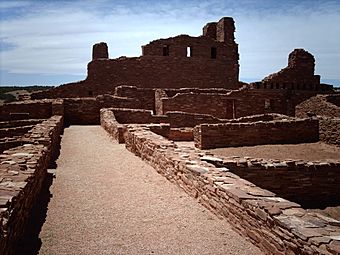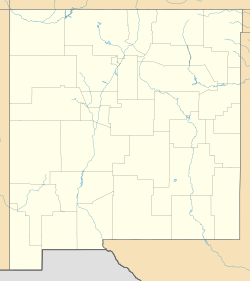Abo (historic place) facts for kids
|
Abo
|
|

Mission ruins at Abó
|
|
| Nearest city | Abo, New Mexico |
|---|---|
| Area | 30 acres (12 ha) |
| Built | 1629 |
| Part of | Salinas Pueblo Missions National Monument (ID66000494) |
| NRHP reference No. | 66000497 |
Quick facts for kids Significant dates |
|
| Added to NRHP | October 15, 1966 |
| Designated NHL | June 13, 1962 |
Abó is an ancient pueblo ruin in New Mexico. It is now protected as part of the Salinas Pueblo Missions National Monument. The ruins are about 9 miles (14.5 km) west of Mountainair. They sit high up, about 6,100 feet (1,859 meters) above sea level. Experts believe the site dates back to the 14th century. Abó was a very important trading center in its time.
Today, visitors can explore the site. There's a small visitor center and a 0.25-mile (0.4 km) trail through the old mission ruins. You can also walk a 0.5-mile (0.8 km) trail around the unexcavated pueblo ruins. Abó was named a National Historic Landmark in 1962.
History of Abó
Abó was once home to a Native American Pueblo community. The people who lived here were called Tompiro. They spoke a language related to Piro and Tiwa. In 1641, records show that more than 1,600 Tompiro people lived in Abó.
Life at Abó
The Tompiro people were Pueblo Indians. This means they lived in villages and were farmers. Their main food was corn. The Abó area is over 6,000 feet (1,800 meters) high. This made farming corn a bit tricky because of the cold winters and little rainfall.
However, Abó was special because it was close to important resources. There were salt deposits nearby and large herds of bison on the Great Plains. The Tompiros became important traders. They exchanged salt, bison skins, and meat between the Plains Indians and the Pueblos in the Rio Grande Valley. They also hunted animals like deer, pronghorn, and rabbits. They gathered wild foods too, such as pinyon pine nuts.
Spanish Arrival and Abandonment
The first time Abó was written about was in 1583. A Spanish explorer named Antonio de Espejo visited a place believed to be Abó. Spanish missionaries began working there in 1622. Construction on the first church at Abó started in 1629.
The Pueblo of Abó was abandoned around 1672. This happened because of a long period of dry weather and attacks from the Apaches. The Spanish wrote that the people of Abó then moved to the Rio Grande valley. Later, they joined the Spanish during the 1680 Pueblo Rebellion.
The state of New Mexico bought the Abó site in 1938. It was protected as a state historic site. In 1981, the National Park Service took over the site. It became part of the Gran Quivira National Monument, which is now called the Salinas Pueblo Missions National Monument.
See also
 In Spanish: Abó (lugar histórico) para niños
In Spanish: Abó (lugar histórico) para niños



